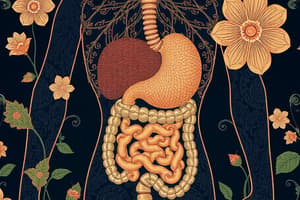Podcast
Questions and Answers
What is the main organ where proper digestion takes place in the midgut?
What is the main organ where proper digestion takes place in the midgut?
- Ventriculus (correct)
- Ileum
- Gastric caeca
- Colon
What structure increases the surface area of the midgut?
What structure increases the surface area of the midgut?
- Ventriculus
- Peritrophic membrane
- Rectum
- Gastric caeca (correct)
What is the primary function of the peritrophic membrane in the midgut?
What is the primary function of the peritrophic membrane in the midgut?
- Production of enzymes
- Protection from abrasion and microbes (correct)
- Absorption of nutrients
- Facilitation of waste removal
During which stage of development does the midgut's lack of cuticle occur?
During which stage of development does the midgut's lack of cuticle occur?
What is a major function of the midgut?
What is a major function of the midgut?
Which part is NOT included in the composition of the hindgut or proctodaeum?
Which part is NOT included in the composition of the hindgut or proctodaeum?
What type of enzymes are found in the midgut?
What type of enzymes are found in the midgut?
Which statement about the hindgut is accurate?
Which statement about the hindgut is accurate?
What is one function of Malpighian tubules in Arachnocampa luminosa?
What is one function of Malpighian tubules in Arachnocampa luminosa?
Which organism produces spittle using its Malpighian tubules?
Which organism produces spittle using its Malpighian tubules?
What is one benefit of spittle production for frogs hoppers?
What is one benefit of spittle production for frogs hoppers?
What role does the spittle serve during extreme heat?
What role does the spittle serve during extreme heat?
In which habitat would you likely find Arachnocampa luminosa larvae?
In which habitat would you likely find Arachnocampa luminosa larvae?
How do Malpighian tubules contribute to the survival of the froghopper?
How do Malpighian tubules contribute to the survival of the froghopper?
What is the main purpose of the luminous structure in Arachnocampa luminosa?
What is the main purpose of the luminous structure in Arachnocampa luminosa?
Which of the following is NOT a function of spittle produced by frog hoppers?
Which of the following is NOT a function of spittle produced by frog hoppers?
What is the main function of tracheoles in the insect body?
What is the main function of tracheoles in the insect body?
What is one of the functions of the insect tracheal system?
What is one of the functions of the insect tracheal system?
What do tracheal trunks primarily connect to in insects?
What do tracheal trunks primarily connect to in insects?
Which statement describes the process of respiration in insects?
Which statement describes the process of respiration in insects?
In what way do air sacs contribute to insect physiology?
In what way do air sacs contribute to insect physiology?
What structural feature of tracheoles resembles networks found in humans?
What structural feature of tracheoles resembles networks found in humans?
How does the tracheal system aid in cooling the body of insects?
How does the tracheal system aid in cooling the body of insects?
What function does the tracheal system serve in fast-flying insects?
What function does the tracheal system serve in fast-flying insects?
Which aspect of the trachea is specifically designed to supply oxygen to the ventral nerve cord?
Which aspect of the trachea is specifically designed to supply oxygen to the ventral nerve cord?
What role do mechanical ventilation and air sacs play in insect respiration?
What role do mechanical ventilation and air sacs play in insect respiration?
Which type of tracheae primarily enables gaseous transfer due to their extensive surface area?
Which type of tracheae primarily enables gaseous transfer due to their extensive surface area?
In what way do abdominal tracheae contribute to the respiratory process?
In what way do abdominal tracheae contribute to the respiratory process?
Which feature distinguishes tracheal trunks from tracheoles?
Which feature distinguishes tracheal trunks from tracheoles?
What is a key characteristic of tracheoles compared to other types of tracheae?
What is a key characteristic of tracheoles compared to other types of tracheae?
During which process is increased body pressure particularly significant in insects?
During which process is increased body pressure particularly significant in insects?
What is a primary requirement for efficient respiration in the insect tracheal system?
What is a primary requirement for efficient respiration in the insect tracheal system?
What is the primary focus of the dissection activity described?
What is the primary focus of the dissection activity described?
Which insect is suggested for the dissection activity?
Which insect is suggested for the dissection activity?
What type of video presentation is encouraged for this activity?
What type of video presentation is encouraged for this activity?
What should students do after learning the basic metabolic processes?
What should students do after learning the basic metabolic processes?
What organ systems should students have gained a full understanding of by the end of the lesson?
What organ systems should students have gained a full understanding of by the end of the lesson?
What resource is provided to assist with the dissection study?
What resource is provided to assist with the dissection study?
Which aspect of the insect is specifically addressed in the lesson learned?
Which aspect of the insect is specifically addressed in the lesson learned?
How does the lesson conclude for the students?
How does the lesson conclude for the students?
Study Notes
Digestive System
- The ventriculus is the primary site of digestion in the middle part of the digestive tract.
- Gastric caeca are finger-like structures in the midgut that increase surface area for digestion.
- The midgut lacks a cuticle, as it develops from endoderm during embryonic development.
- The midgut plays a key role in digestion and absorption.
- The peritrophic membrane in the midgut protects the cells from abrasion by food particles and microbes.
- The midgut contains enzymes that break down large food molecules into smaller, absorbable forms.
- The hindgut comprises the ileum, colon, and a short, expanded rectum connected to the anus.
Excretory System
- Malpighian tubules are involved in excretion, osmoregulation, and maintaining internal fluid balance.
- The Malpighian tubules are responsible for filtering waste products from the hemolymph, which is the insect's blood.
- The tubules contain cells that actively transport waste products into their lumen, where they are excreted into the hindgut.
- Waste products, primarily nitrogenous wastes, are eliminated in the form of uric acid.
- Malpighian tubules also play a role in regulating water balance, absorbing water from the hindgut.
- Their structure and function make them efficient at both excreting waste and conserving water, which is vital for insect survival in diverse environments.
Respiratory System
- The tracheal system is a network of tubes responsible for gas exchange in insects.
- Spiracles are openings on the insect's body that allow air to enter the tracheal system.
- Tracheal trunks are large, longitudinal tubes that carry air directly to the head.
- Tracheoles are microscopic tracheae which deliver oxygen directly to cells and tissues.
- Air sacs function as bellows, distributing air and cooling the body, increasing body pressure during molting, and as reservoirs for oxygen.
- The tracheal system facilitates the diffusion of oxygen and carbon dioxide, aided by mechanical ventilation.
Additional Uses of Malpighian Tubules
- Some insects, like Arachnocampa luminosa, use Malpighian tubules for light production.
- The froghopper (spittle bug) uses its Malpighian tubules to produce** spittle** for protection, insulation, and preventing dehydration.
Tracheal System Details:
- Ventral segmental trachea branch ventrally and supply oxygen to muscles and the ventral nerve cord.
- Tracheal trunks carry oxygen directly to the head.
- Tracheoles are microscopic tracheae supplying oxygen directly to tissues and cells, resembling capillary networks in humans.
- Air sacs are expansions of the tracheal trunks.
Studying That Suits You
Use AI to generate personalized quizzes and flashcards to suit your learning preferences.
Related Documents
Description
Test your knowledge on the digestive and excretory systems, focusing on key structures like the ventriculus, gastric caeca, and Malpighian tubules. This quiz covers essential functions, processes, and anatomical details crucial for understanding these systems.





